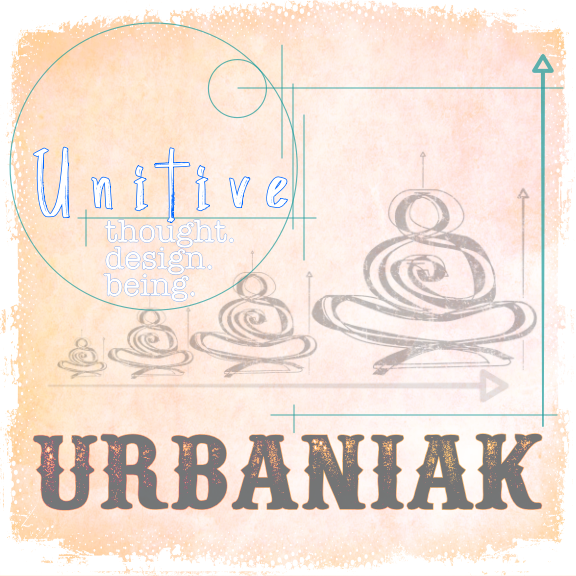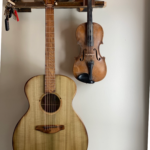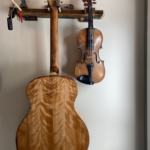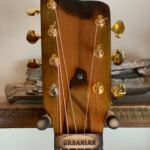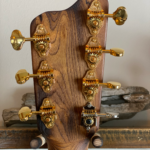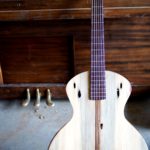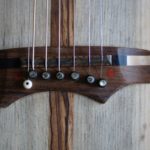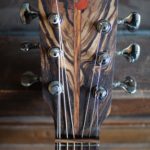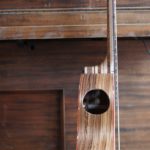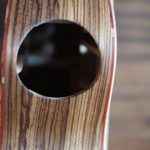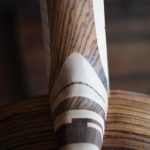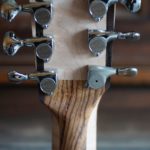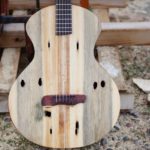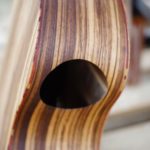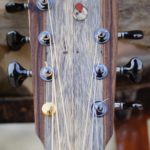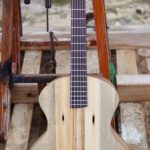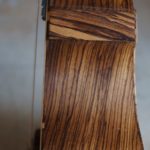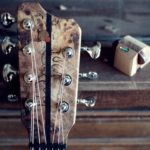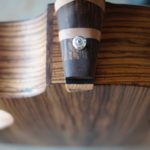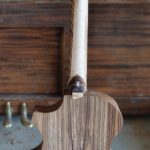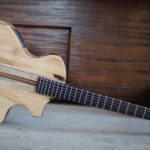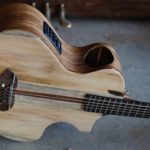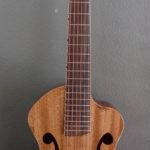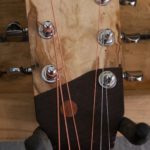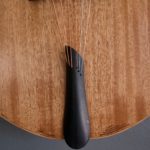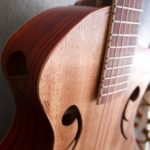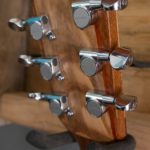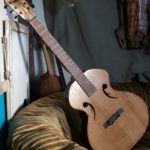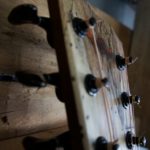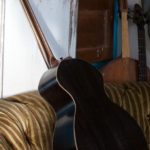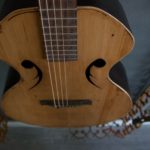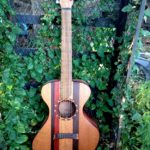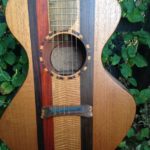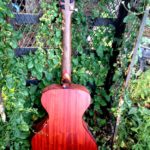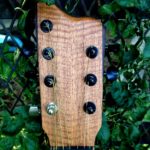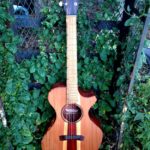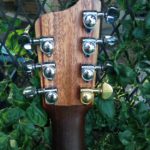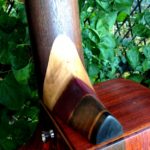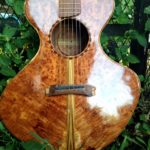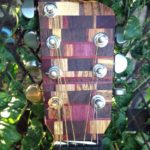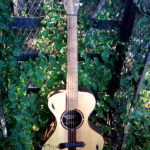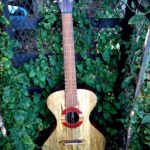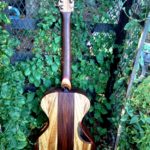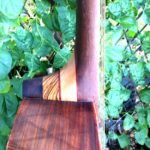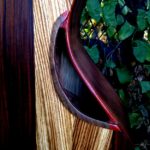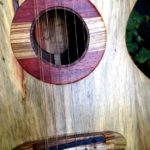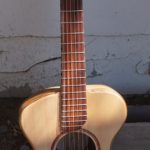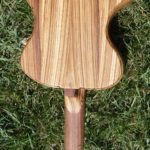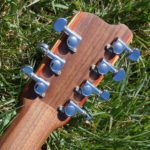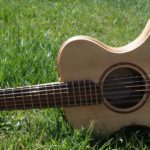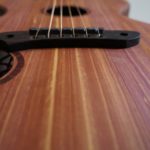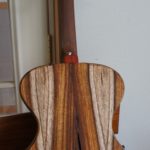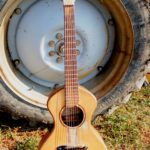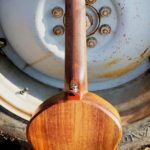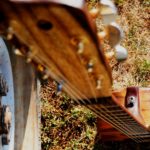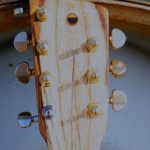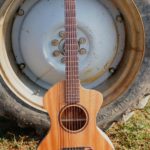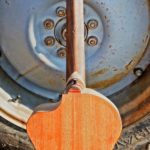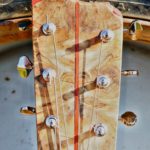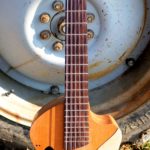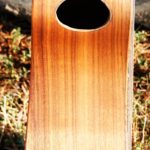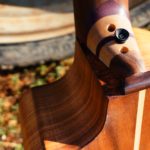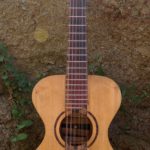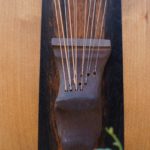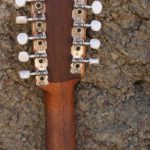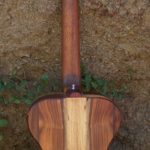Guitar
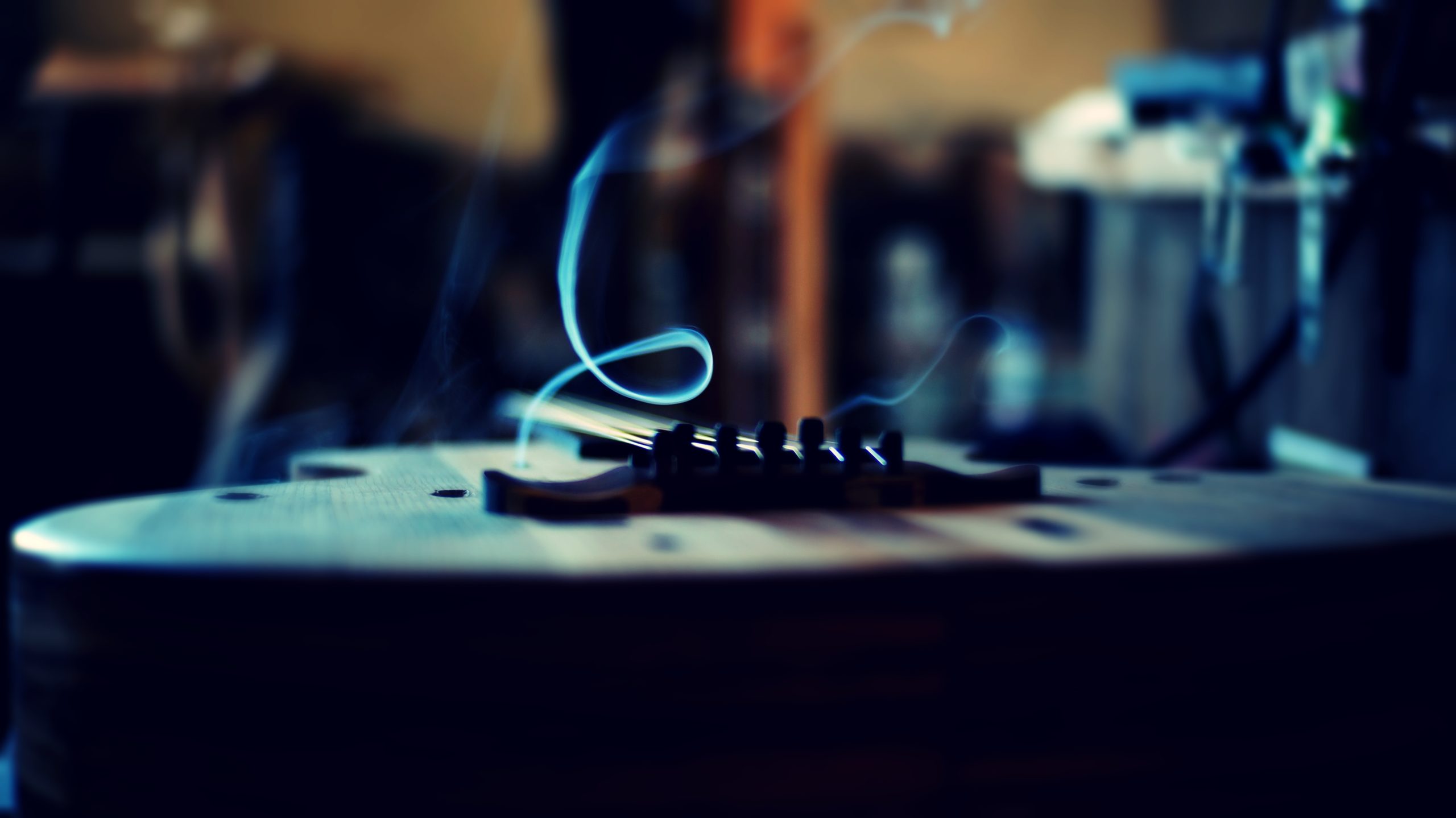
Jumbo 001 – an actual Jumbo and not just an almost jumbo…
This entire guitar was pulled out of two ultra old pianos: a Kimball (116 y.0.) and a McPherson (111+- y.o.). It’s not often that I see the back supports of a piano that are laminated, so when I dug into them with the saw, I was a little surprised. Knowing that steam, heat, and bending aren’t exactly friends of the hopeful permanence of glue, the problem wasn’t in keeping the slats together, but was found in figuring out how to artistically solve the separation while keeping the necessary integrity that sides must have. Answer: light it on fire. Other part of the answer: brace the insides and then light it on fire again.
Because it’s easy to get carried away with lighting instruments on fire it was easy letting the torch blast its way around! What inspired this: A comment about how the neighbor nearly lit the fence by the shop on fire last spring…burnt fences are madly adorable and inspiring.
My feeling was not single threaded, but was instead multidimensional: The guitar felt old and full of memories. Not all of these were held in the physical showing of the instrument; some carried through in an ethereal sort of way…anyhow…
Ghueshundt.
This guitar was built as a near replica of the Ghueshundt below. Even so, they never come out quite identical. The biggest difference is actually technical with the neck coming in on the 14th fret (common) instead of the 12th (strummers guitar).
Ghueshundt. Almost nearly a jumbo – almost. 12th fret to body…
Wormy Scotch Pine top, Zebrawood back and sides, Padouk grafting around the edges, and the insides are all spruce braces reclaimed from 100+ year old piano soundboards. Gotoh 510 21:1 machine heads, and maybe you noticed the seventh string? It’s a double (or single if preferred) octave up from the low e, and what it adds is beautiful.
Elephant Tour – 004. A strange oddity indeed.
Only five of these guitars exist, and never shall there be more. This guitar went along with the Gheushundt from the above photo, and has many of the same wood features, and also includes the player side sound hole.
Ghoti-ca-002 (The Ghoti is a slightly remodeled Lighthouse style guitar – small body with the 14″ lower bout)
African Mahogany top and back, Paudouk sides, ebony tailpiece recycled from old an old cello that was a student instrument in the 70’s, Black Walnut neck, Rosewood fretboard, Tacoma (Gotoh) machine heads, Ash headstock that is bound with Leopard wood with Maple and Wenge veneer.
These f-hole cutouts on this guitar were only used on a couple instruments and a side sound hole was also implemented.
Gheushundt – 01
Fir top from a 100+ year old piano, Wenge back and sides, laminated Figured Maple and Black Walnut neck, Gotoh 510 machine heads, Spalted Tamarin headstock veneer, plug-through-body string fixture.
The Gheushundt is the largest acoustic guitar that I make. It’s full width, jumbo bottomed but still with the tight waist for big sound. The f-holes are not common and they usually have the regular sound hole and rosette.
2013 Lighthouse Model
Paudouk back and sides, Spanish Cedar top with Paudouk and Indian Rosewood stripes. Peruvian Walnut grafting, Black Walnut neck with a stacked heal block and a Spanish Cedar head stock veneer. Tacoma (Gotoh) machine heads and the seventh string.
Lighthouse – ca
Redwood Top with a Paudouk middle, Paudouk back and sides and a Peruvian Walnut stripe down the back, stacked heal block, Peruvian Walnut neck, Mahogany headstock with a Rosewood veneer, Grover machine heads.
Thostle.
Redwood Burl top with a Zebra Wood center stripe, Peruvian Walnut back and sides, Black Walnut neck, headstock veneer created from the heal block cutoffs of the other guitars, Grover machine heads.
The Thostle has a larger lower bout than the original Lighthouse (now Ghoti) guitars as well as the ergonomically defined shape.
Lighthouse
Distressed Spruce and Peruvian Walnut top with a Rosewood center stripe, Black Walnut neck and Zebrawood veneer.
Lighthouse
Blue Pine top with a Paudouk and Zebrawood rosette on the outside, Morado sides, Zebrawood and Morado back with a sound port, Peruvian Walnut neck, and stacked heal block.
Lighthouse – 002
Recycled Spruce top, Zebrawood back and sides, Black Walnut neck. These were the smallest guitars that I built that were similar to a parlor guitar but meant as an ergonomic approach to shape and function as well as being a better stage guitar.
Every instrument I build is in nearly all ways hand built. Over the years I’ve become considerably better at consistency of form, but still each instrument can be felt and understood as hand formed, hand built.
Lighthouse – 001
Koa wood back and sides. Fence post top – Juniper – with two sound holes. This was a prototype guitar that implemented the use of asymmetry and an idea of ergonomics and stage value. I used it to record and film One-way Ticket, and then gifted it. These are the only two pictures I have of this bugga.
Ghoti – 001
Spruce top with a Koa wood center stripe, wormy Koa back and sides, Black Walnut neck, Koa headstock veneer, Grover machine heads.
This is my personal guitar that has made the journey across our country many times. The small body and the setup make this such an amazing stage guitar although it’s great to pluck on acoustically, too.
Ghoti – 004 – Short scale Baritone
African Mahogany front and back, Figured Maple sides, Paudouk grafting, Black Walnut neck, root ball headstock veneer, Grover rotomatic machine heads. Short scale Baritones can be restrung as a normal 6 ‘E to E’ six string, but it is setup with a Raised or octave up ‘B’ string to B. All chord shapes are the same but the dynamic in sound is huge.
All instruments now have either mostly or all completely tucked bracing. The white segments that are visible around the seam are the ends of the braces that have been sequestered by the Paudouk grafting. All braces inside the guitar are also tucked under one another.
Bari – 003 – Long Scale 27.5″
This guy is a monster! The holes in the Fir top are from nails when the top was a stair tread in an old house. Black Walnut back and sides, no grafting, maple back stripe, Black Walnut neck with Purple Heart headstock veneer that has been electrocuted with a step up transformer. Gotoh pearl button machine heads and the option for the 7th string. Strung up low B to B and with that scale length it is growly.
12 string symmetrical Thostle – 001
Piano board spruce top, Morado center stripe back and sides.
